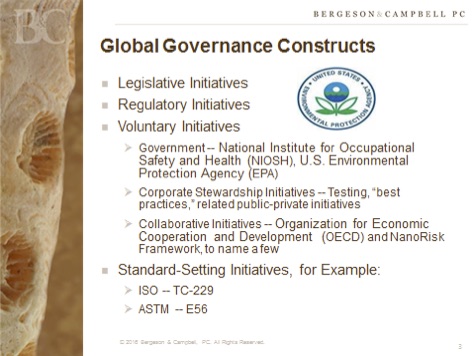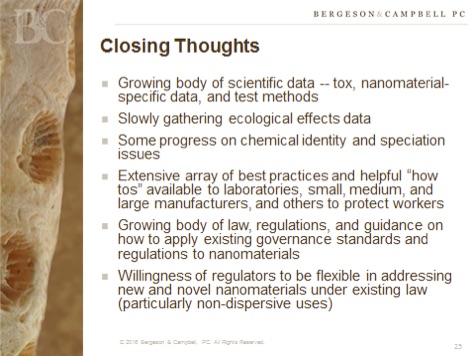Lynn L. Bergeson Presents “The Nanotechnology Legal and Regulatory Landscape” at the 2016 International Nanotoxicology Congress
On June 2, 2016, Lynn L. Bergeson, Managing Partner of Bergeson & Campbell, P.C. (B&C®), presented “The Nanotechnology Legal and Regulatory Landscape” at the 2016 International Nanotoxicology Congress in Boston. Ms. Bergeson stated that there are many ongoing global initiatives involving diverse governance aspects of nanoscale materials and many countries continue to make progress in defining nanoscale materials, addressing related definitional challenges, developing suitable governance approaches to manage potential risks, and conducting testing while developing alternative test methods. There exists a consensus globally that existing laws are sufficiently robust to regulate the safety of nanoscale materials, with the Organization for Economic Cooperation and Development (OECD) announcing on June 9, 2015, that its seven-year testing program “showed that the standard test guidelines used for normal chemical substances are in the most part suitable for use on namomaterials.” Ms. Bergeson then described the U.S. Environmental Protection Agency’s (EPA) June 2011 proposed policy on nanoscale materials in pesticide products. EPA proposed obtaining information concerning nanoscale materials using either Federal Insecticide, Fungicide, and Rodenticide Act (FIFRA) Section 6(a)(2), which concerns adverse effects reporting, or a data call-in (DCI) under FIFRA Section 3(c)(2)(B). EPA has also proposed reporting and recordkeeping requirements under the Toxic Substances Control Act (TSCA) Section 8(a) Rule for certain chemical substances when they are manufactured or processed at the nanoscale. Additionally, the U.S. Food and Drug Administration (FDA) has recently published final guidance on FDA-regulated products, cosmetics, food ingredients and food contact substances, and food for animals.
Ms. Bergeson stated that nanotechnology regulations are developing internationally as well, with France, Belgium, Sweden, and Denmark setting up nano product inventories, and European Commission (EC) officials discussing a revision of the Registration, Evaluation, Authorization and Restriction of Chemicals (REACH) Annexes to require manufacturers to provide specific data concerning nanomaterials. Despite intending to update the Annexes in 2015, the EC has not yet done so, and is reportedly balancing the need for clarity with the costs for companies, especially for small- and medium-sized enterprises (SME). Because of the delay in amending the Annexes, the European Chemicals Agency (ECHA) intends to have a draft or final update of all registration guidance on its website, including what is required in the context of nanomaterials, before the effective date of the guidance moratorium, May 31, 2016. Throughout all of this, it is important to pay attention to the growing body of law, regulations, and guidance on regulating nanomaterials and remember that regulators must be flexible in addressing new and novel nanomaterials under existing law.
For a copy of Lynn L. Bergeson’s full presentation, e-mail hlewis@lawbc.com. B&C has been at the forefront of the science-policy debate and has been instrumental in the progress of and integration of nanotechnologies. Visit our website for more information on our nanotechnology services, Regulatory Memoranda regarding nanotechnology, and articles.


